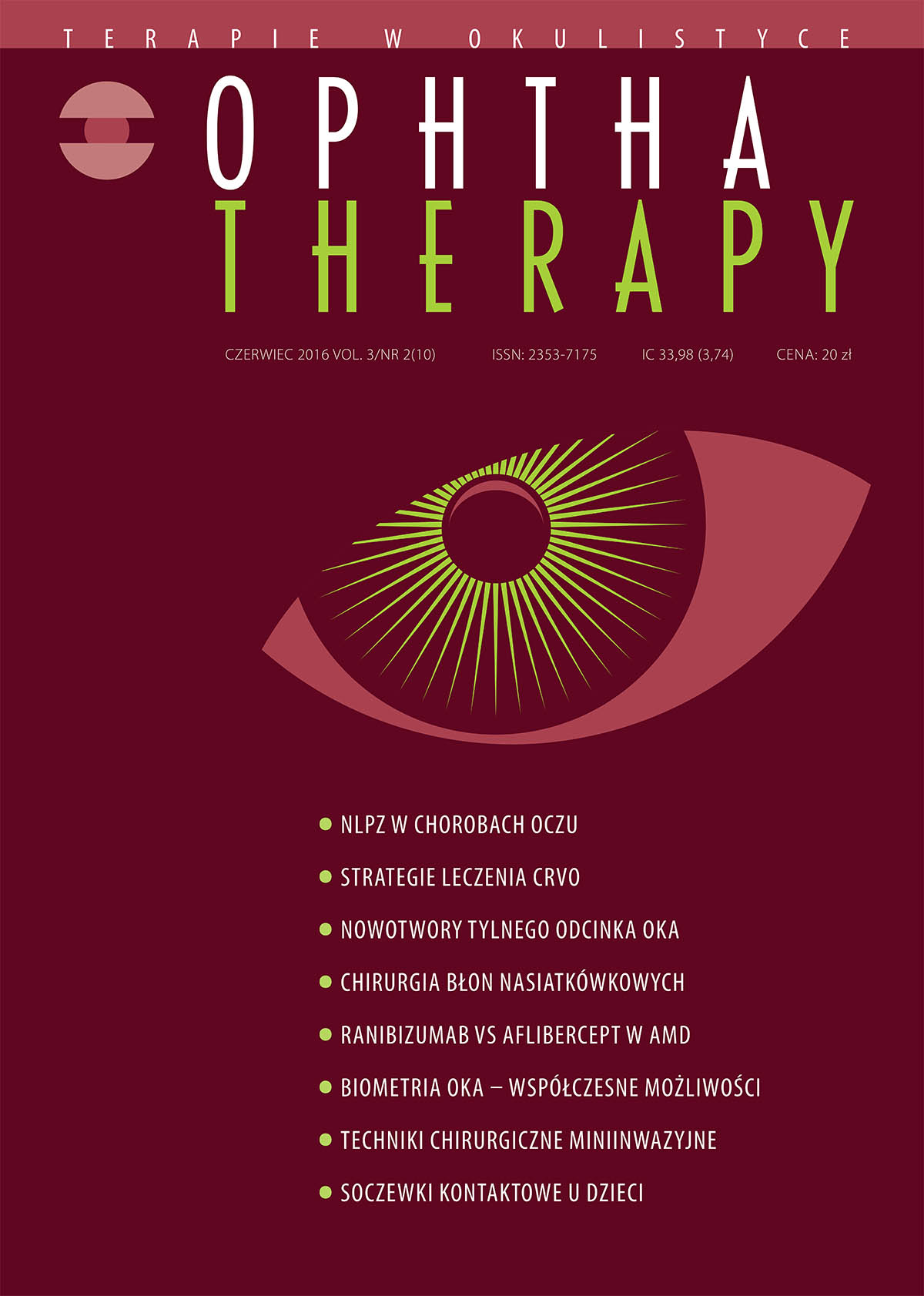Zastosowanie technik miniinwazyjnych w chirurgii zaćmy i witrektomii
##plugins.themes.bootstrap3.article.main##
Abstrakt
W chirurgii okulistycznej od wielu lat dąży się do miniaturyzowania narzędzi oraz minimalizowania ran operacyjnych. Zastosowanie instrumentarium o małej średnicy w chirurgii zaćmy (cięcie od 1,8 do 2,2 mm) i witrektomii (23G, 25G i 27G) umożliwia wykonywanie małych cięć, co eliminuje szycie oraz skraca czas zabiegu, a następnie przyspiesza powrót do zdrowia po operacji. Nowe systemy operacyjne do witrektomii pozwalają na przeprowadzenie zabiegu chirurgicznego dużej szybkości cięć (7500/min) oraz umożliwiają łatwą zmianę pomiędzy modułem witrektomii i fakoemulsyfikacji. Rozwój nowych technik operacji zaćmy wymógł pojawienie się nowych narzędzi chirurgicznych, urządzeń do fakoemulsyfikacji, a także nowych soczewek wewnątrzgałkowych. Wyniki anatomiczne i funkcjonalne technik małego cięcia w witrektomii i operacji zaćmy są lepsze niż rezultaty zabiegów wykonywanych konwencjonalnymi technikami. Dodatkową korzyścią jest większe zadowolenie pacjentów.
Pobrania
##plugins.themes.bootstrap3.article.details##

Utwór dostępny jest na licencji Creative Commons Uznanie autorstwa – Użycie niekomercyjne – Bez utworów zależnych 4.0 Międzynarodowe.
Copyright: © Medical Education sp. z o.o. License allowing third parties to copy and redistribute the material in any medium or format and to remix, transform, and build upon the material, provided the original work is properly cited and states its license.
Address reprint requests to: Medical Education, Marcin Kuźma (marcin.kuzma@mededu.pl)
Bibliografia
2. Eckardt C. Transconjunctival sutureless 23-gauge vitrectomy. Retina. 2005; 25(2): 208-11.
3. Hubschman JP, Gupta A, Bourla DH et al. 20-, 23-, and 25-gauge vitreous cutters: performance and characteristics evaluation. Retina. 2008; 28(2): 249-57.
4. Fabian ID, Moisseiev J. Sutureless vitrectomy: evolution and current practices. Br J Ophthalmol. 2011; 95(3): 318-24.
5. Diniz B, Fernandes RB, Ribeiro RM et al. Analysis of a 23-gauge ultra high-speed cutter with duty cycle control. Retina. 2013; 33(5): 933-8.
6. Steel DH, Charles S. Vitrectomy fluidics. Ophthalmologica. 2011; 226(suppl. 1): 27-35.
7. Sugiura Y, Okamoto F, Okamoto Y et al. Intraocular pressure fluctuation during microincision vitrectomy with constellation vision system. Am J Ophthalmol. 2013; 156(5): 941-7.
8. Arevalo JF, Berrocal MH, Arias JD et al. Minimally invasive vitreoretinal surgery: is sutureless vitrectomy the future of vitreoretinal surgery? J Ophthalmic Vis Res. 2011; 6(2): 136-44.
9. Ohji M, Tano Y. A stiffer and safer light pipe for 25-gauge vitrectomy. Arch Ophthalmol. 2007; 125(10): 1415-6.
10. Kaiser PK, Moshfeghi D, Barakat M et al. Enhancements for microincision surgery. Paper presented at Vail Vitrectomy. March 13-17, 2010.
11. Magalhaes O, Chong LM, DeBoer CB et al. Vitreous dynamics: Vitreous flow analysis in 20-, 23-, and 25-gauge cutters. Retina. 2008; 28(2): 236-41.
12. Fang SY, DeBoer CM, Humayun MS. Performance analysis of new-generation vitreous cutters. Graefes Arch Clin Exp Ophthalmol. 2008; 246(1): 61-7.
13. Sandali O, El Sanharawi M, Lecuen N. 25-, 23-, and 20-gauge vitrectomy in epiretinal membrane surgery: a comparative study of 553 cases. Graefes Arch Clin Exp Ophthalmol. 2011; 249(12): 1811-9.
14. Kelman CD. Phaco-emulsification and aspiration. A new technique of cataract removal. A preliminary report. Am J Ophthalmol. 1967; 64(1): 23-35.
15. Mazzocco TR, Davidson BM. Insertion technique and clinical experience with silicone lenses. In: Mazzocco TR, Rajacich GM, Epstein E (ed). Soft Implant Lenses in Cataract Surgery. Slack, New Jersey 1986: 97-106.
16. Alió J, Rodriguez-Prats JL, Galal A. Advances in microincision cataract surgery intraocular lenses. Curr Opin Ophthalmol. 2006; 17(1): 80-93.
17. Alió JL, Elkady B, Ortiz D. Corneal Optical Quality Following Sub 1.8 mm Micro-Incision Cataract Surgery vs. 2.2 mm Mini-Incision Coaxial Phacoemulsification. Middle East Afr J Ophthalmol. 2010; 17(1): 94-9.
18. Alió J, Rodriguez-Prats JL, Galal A et al. Outcomes of microincision cataract surgery versus coaxial phacoemulsification. Ophthalmology. 2005; 112(11): 1997-2003.
19. Han YK, Miller KM. Comparison of vacuum rise time, vacuum limit accuracy, and occlusion break surge of 3 new phacoemulsification systems. J Cataract Refract Surg. 2009; 35(8): 1424-9.
20. Sharif-Kashani P, Fanney D, Injev V. Comparison of occlusion break responses and vacuum rise times of phacoemulsification systems. BMC Ophthalmol. 2014; 14: 96.
21. Liu Y, Zeng M, Liu X. Torsional mode versus conventional ultrasound mode phacoemulsification: randomized comparative clinical study. J Cataract Refract Surg. 2007; 33(2): 287-92.
22. Rekas M, Montés-Micó R, Krix-Jachym K et al. Comparison of torsional and longitudinal modes using phacoemulsification parameters. J Cataract Refract Surg. 2009; 35(10): 1719-24.
23. Chen M, Anderson E, Hill G. Comparison of cumulative dissipated energy between the Infiniti and Centurion phacoemulsification systems. Clin Ophthalmol. 2015; 9: 1367-72.
24. Han YK, Miller KM. Heat production: Longitudinal versus torsional phacoemulsification. J Cataract Refract Surg. 2009; 35(10): 1799-805.
25. Vasavada AR, Vasavada V, Vasavada VA. Comparison of the effect of torsional and microburst longitudinal ultrasound on clear corneal incisions during phacoemulsification. J Cataract Refract Surg. 2012; 38(5): 833-9.

